It is not an easy task to make the water supply to a private house or dacha permanent and uninterrupted. The most difficult thing is to ensure water supply in winter. To keep the pipes from freezing, they can be laid below the frost depth, but there are still weak points. The first is abnormally cold winters, which periodically break all records. The second is the entry points into the house. They still often freeze. The way out is to install a heating cable for the water supply. In this case, the sewer is desirable, but bury it can be shallow. And at the sites of entry into the house, you can lay a heater more powerful and better insulated.
Conteúdo do artigo
Types of heating cables for plumbing
There are two types of heating cables – resistive and self-regulating. In resistive used the property of metals in the passage of electric current to heat up. In heating cables of this type, the metal conductor is heated. Their characteristic feature is that they always emit the same amount of heat. No matter if it is +3°C or -20°C outside, they will be heated in the same way – at full power, therefore, they will consume the same amount of electricity. To reduce costs in relatively warm times, the system is equipped with temperature sensors and thermostat (the same as used for electric floor heating).
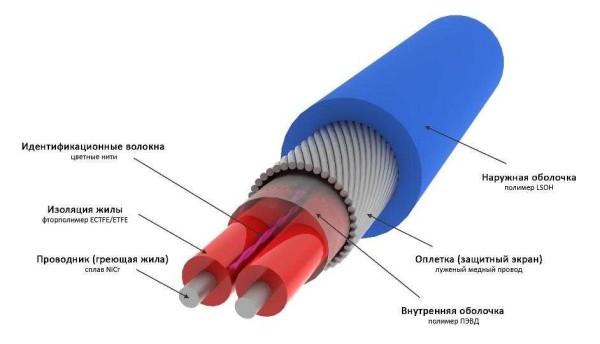
Resistive heating wires when laying should not cross or be located near each other (closely). If they do, they will overheat and fail quickly. Carefully observe this point during the installation process.
It is also worth saying that the resistive heating cable for plumbing (and not only) is single and double-core. More often used two-core, although they are more expensive. The difference in the connection: single-core should be connected to the power grid both ends, which is not always convenient. Two-core on one end have a plug, on the second – fixed ordinary electric cord with a plug, which is included in the network 220 V. What else should I know? Resistive conductors can not be cut – they will not work. If you bought a coil with a longer than necessary section – lay it whole.
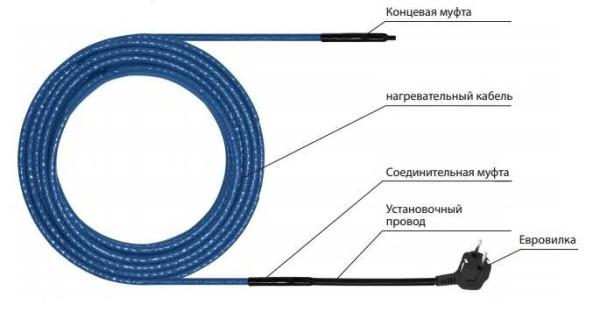
Self-regulating cables are a metal-polymer matrix. In this system, the wires only conduct current, but the polymer that is between the two conductors is heated. This polymer has an interesting property – the higher its temperature, the less heat it releases, and vice versa, cooling down, it begins to release more heat. These changes occur regardless of the state of neighboring sections of the cable. So it turns out that it regulates its own temperature, that’s why it is so called – self-regulating.
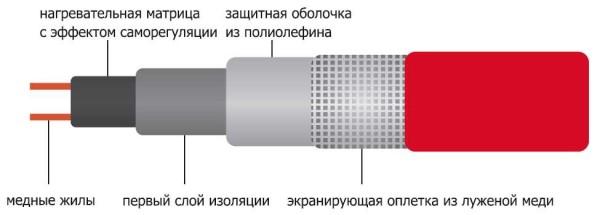
Self-regulating (self-heating) cables have a lot of advantages:
- they can be crossed and will not burn out;
- they can be cut (there are markings with cutting lines), but it is then required to make a termination coupling.
Minus they have one – a high price, but the service life (if the rules of operation are observed) is about 10 years. So these expenses are reasonable.
Using heating cable for water pipes of any type, it is desirable to insulate the pipeline. Otherwise, the heating will require too much power, and therefore high costs, and not the fact that heating will cope with particularly severe frosts.
Métodos de instalação
Heating cable for water pipes is laid outside or inside the pipe. For each method there are special types of wires – some only for external installation, others – for internal. The method of installation is necessarily specified in the technical specifications.
Inside the pipe
To install the heating element inside the water pipe, it must meet several requirements:
- the shell must not emit harmful substances;
- the degree of electrical protection must be at least IP68;
- a hermetically sealed termination sleeve.
In order to be able to tuck the wire inside, at the end of the pipeline put a tee, in one of the branches of which through the gland (comes in a set) is wound wire.
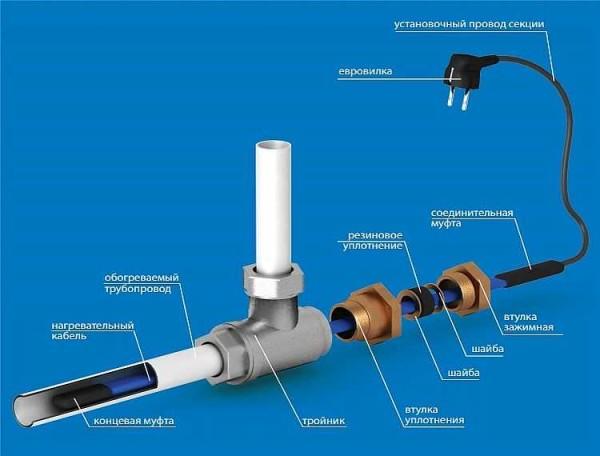
Please note that the coupling – the transition point between the heating cable and the electric cable – must be outside the pipe and the gland. It is not intended for wet environments.
The tee for installing the heating cable inside the pipe can have different branching angles – 180°, 90°, 120°. In this method of installation, the wire is not fixed in any way. It is simply tucked inside.
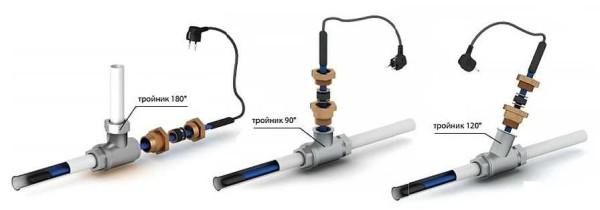
External installation
Fix the heating cable for water pipes on the outer surface of the pipe should be so that it adheres tightly, the entire area. Before installation on metal pipes, they are cleaned of dust, dirt, rust, welding marks, etc. There should not be any elements left on the surface that can damage the conductor. The conductor is laid on the clean metal, fixed every 30 cm (more often you can, less often – not) with metallized adhesive tape or plastic clamps.
If one or two strings are pulled along, they are mounted from the bottom – in the coldest zone, laid in parallel, at some distance from each other. When laying three or more wires, they are arranged so that most of them are at the bottom, but the distance between the heating cables is maintained (especially important for resistive modifications).
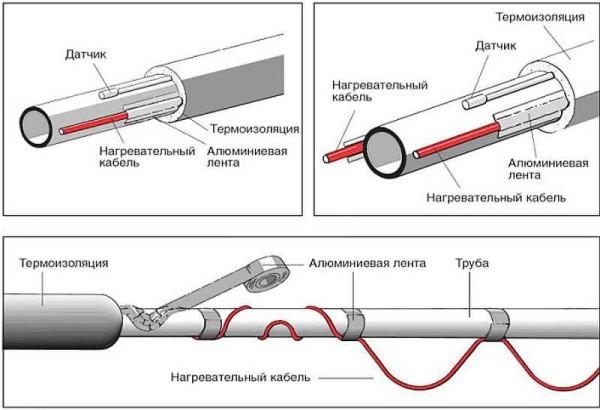
There is a second method of installation – spiral. Lay the wire must be carefully – they do not like sharp or repeated bends. There are two ways. The first is to unwind the coupling gradually winding the released cable on the pipe. The second – to fix it with sags (bottom picture on the photo), which then wind up and fasten with metallized adhesive tape.
If the water pipe made of plastic will be heated, then under the wire is glued first metallized tape. It improves thermal conductivity, increasing the efficiency of heating. Another nuance of installing heating cable on the water pipe: tees, valves and other similar devices require more heat. When laying, make several loops on each fitting. Only watch out for the minimum bend radius.
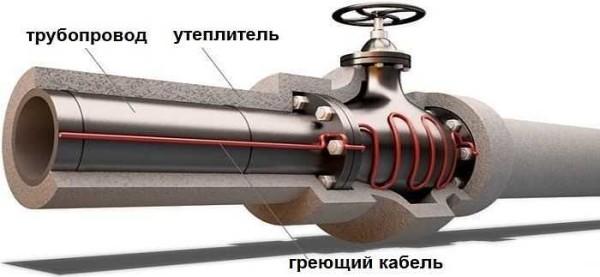
What to insulate with
It is definitely undesirable to use mineral wool of any origin to insulate the heated pipeline. It is afraid of getting wet – in a wet state it loses its thermal insulation properties. Having frozen in a wet state, after the temperature rise, it simply crumbles into dust. The absence of moisture around the pipeline is very difficult to ensure that this insulation is better not to take.
Not very good insulators, which are compressed under the action of gravity. Compressed, they also lose their insulating properties. If the pipeline you have laid in a specially constructed sewer, it can not be pressed on anything, you can use and foam rubber. But if you just bury the pipe, you need a rigid thermal insulation. There is another option – over the crumpled insulation (for example, closed-cell polyethylene foam) to put a rigid pipe, for example – plastic sewer.
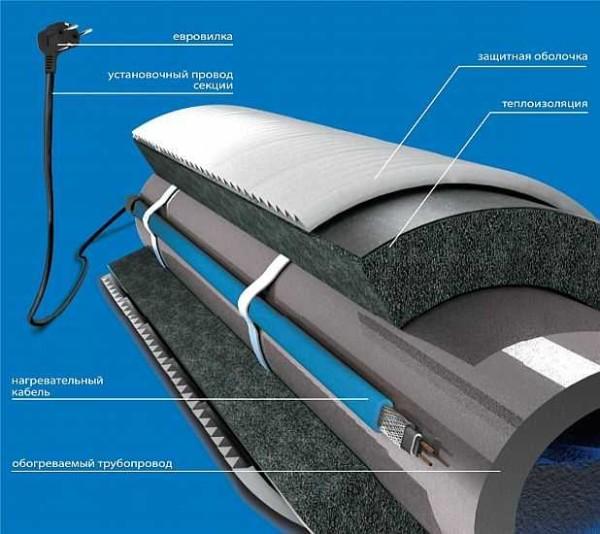
Another material – polystyrene foam, molded in the form of pipe fragments of different diameters. This type of insulator is often called a shell. It has good thermal insulation characteristics, is not afraid of water, endures some loads (depending on the density).
What power is required heating cable for water pipes
The required power depends on the region in which you live, on how the pipeline is laid, on the diameter of the pipes, whether it is insulated or not, and also on how exactly you lay the heating – inside the pipe or on top of it. In principle, each manufacturer has tables that determine the consumption of cable per meter of pipe. These tables are made for each power, so there is no sense to lay out here any of them.
By experience, we can say that with an average insulation of the pipeline (polystyrene foam shell with thickness of 30 mm) in the Central strip of Russia to heat one meter of pipe from the inside is enough power of 10 W/m, and outside you need to take at least 17 W/m. The farther north you live, the more power (or thicker insulation) you need.
With or without a thermostat?
If you want to pay a pittance for heating the water supply, it is better to put a thermostat. Even if you are going to mount a self-regulating heating cable. Basically, the characteristics are as follows: it turns on at +3°C, turns off at +13°C.
If your water is supplied from a well, it will never have a temperature of +13°C. It turns out that the heating will work all the time, even in spring and summer. In summer, of course, the cable can be turned off, but in spring and fall you can not do this because of the possibility of sudden frost. With wells is somewhat easier, but not much – in summer, the water there can have a temperature slightly above the cut-off threshold. But this is – in the summer, and in the hottest period. And in general, why do you need to heat, say, the water that goes into the cistern? And the one that goes to the kitchen or shower you will still heat boilers or flow water heaters.
In any case, you need a thermostat. On it you set the cut-off temperature around +5°C. Costs for heating the pipeline fall in times. At the same time, the service life of heating cables is significantly increased – they have a certain resource of working hours. The less they work, the longer they will serve you.
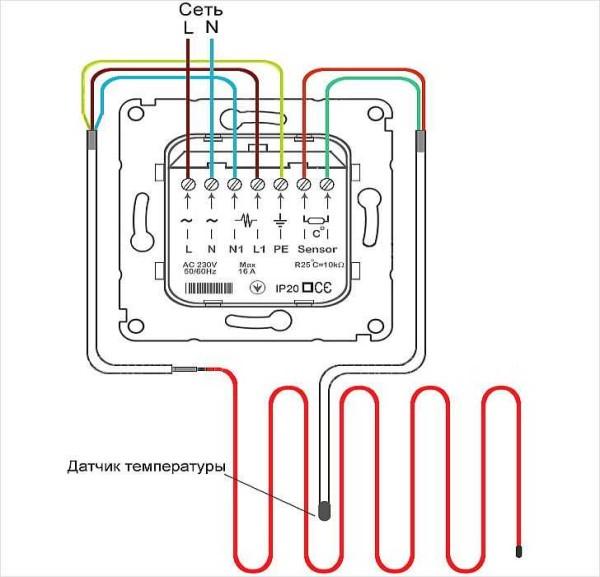
When installing a heating system for water pipes with a thermoregulator, you will need to install a temperature sensor. There is a difficulty here. It must be placed on the pipe so that it is not affected by the temperature from the heaters. That is, it should not be insulated from the pipe, but it should be insulated from the cables.
It is desirable to install the thermoregulator itself in the room. It is connected to the house electric switchboard through a circuit breaker and, preferably, an RCD. The power consumption of the heating cable is small, so the nominal value of the automatic circuit breaker can be taken about 6A, the nominal value of the RCD choose the nearest larger, and then the leakage, preferably 30 mA.
Connect the heating cable for plumbing to the appropriate connectors on the body of the thermoregulator. If there are several branches, they are paralleled. A temperature sensor is connected to the neighboring contacts. Each thermoregulator has a marking on which it is clear what and where to connect. If there are no markings, it is better to buy another one: the operability of this copy is very doubtful.

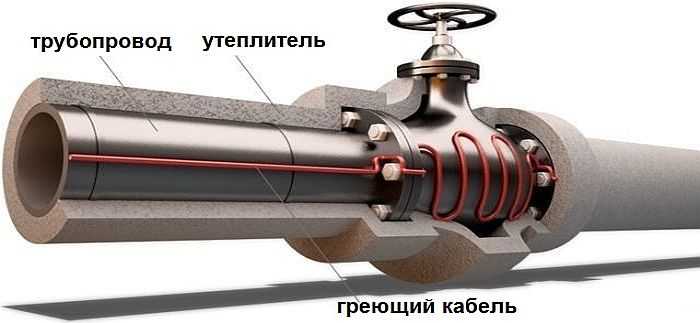
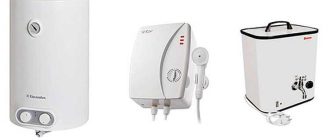

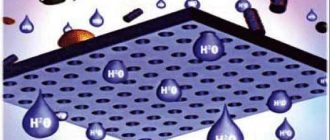
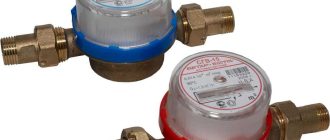
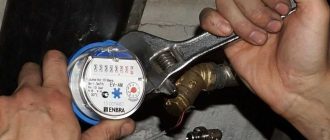

So, I recently installed a heating cable on my water pipes after hearing about those freeze risks in winter. It was pretty straightforward! Now I don’t have to worry about getting stuck with frozen pipes. Definitely worth it for peace of mind during the cold months!
I recently installed a heating cable for my water pipes, and it’s a game changer! No more worrying about frozen pipes during winter. Super easy to set up and reliable. Totally worth it to keep things running smoothly. Highly recommend it to anyone living in cold areas!